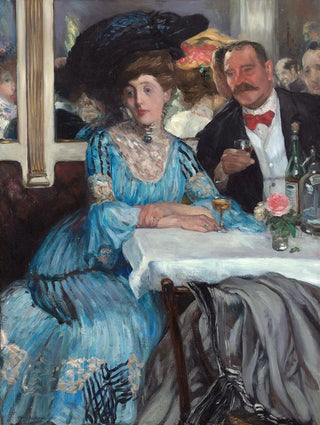Art print | Chez Mouquin's - William James Glackens


View from behind

Frame (optional)
William James Glackens – Engaging Introduction
In the captivating world of art, some works manage to capture the essence of an era while telling a unique story. "Chez Mouquin's" by William James Glackens is one of those creations that evoke a vibrant, almost tangible atmosphere. This painting, created at the end of the 19th century, immerses us in the universe of everyday New York life, where American Impressionism takes full flight. Through this piece, Glackens invites us to share a moment of conviviality, to explore human interactions, and to appreciate the beauty of simple moments. The art print of this work allows you to relive this artistic experience, while offering a window into the past.
Style and uniqueness of the work
Glackens' style is distinguished by his ability to blend realism with an Impressionist touch, creating a luminous and dynamic atmosphere. In "Chez Mouquin's," vibrant colors and bold brushstrokes bring the scene to life, where one can almost hear the murmur of conversations and the clinking of glasses. The artist excels in depicting human figures, capturing not only their features but also their emotions and interactions. The use of light is particularly remarkable, illuminating faces and objects with a delicacy that evokes the warmth and intimacy of a Parisian café. Every detail, from the decor to the characters' clothing, is carefully observed, demonstrating Glackens' keen eye for urban life.
The artist and his influence
William James Glackens, an emblematic figure of the American Impressionist movement, played a crucial role in the evolution of art in the early 20th century. His artistic journey is marked by an relentless quest for beauty in everyday life. Glackens was influenced by his European contemporaries, notably French Impressionists, but developed a style that is uniquely his own, rooted in American culture. His innovative approach paved the way for many artists, and his work continues to inspire future generations. By depicting scenes of daily life, he established a dialogue between art and the public, making art accessible and relevant. The richness of his work,

Matte finish

View from behind

Frame (optional)
William James Glackens – Engaging Introduction
In the captivating world of art, some works manage to capture the essence of an era while telling a unique story. "Chez Mouquin's" by William James Glackens is one of those creations that evoke a vibrant, almost tangible atmosphere. This painting, created at the end of the 19th century, immerses us in the universe of everyday New York life, where American Impressionism takes full flight. Through this piece, Glackens invites us to share a moment of conviviality, to explore human interactions, and to appreciate the beauty of simple moments. The art print of this work allows you to relive this artistic experience, while offering a window into the past.
Style and uniqueness of the work
Glackens' style is distinguished by his ability to blend realism with an Impressionist touch, creating a luminous and dynamic atmosphere. In "Chez Mouquin's," vibrant colors and bold brushstrokes bring the scene to life, where one can almost hear the murmur of conversations and the clinking of glasses. The artist excels in depicting human figures, capturing not only their features but also their emotions and interactions. The use of light is particularly remarkable, illuminating faces and objects with a delicacy that evokes the warmth and intimacy of a Parisian café. Every detail, from the decor to the characters' clothing, is carefully observed, demonstrating Glackens' keen eye for urban life.
The artist and his influence
William James Glackens, an emblematic figure of the American Impressionist movement, played a crucial role in the evolution of art in the early 20th century. His artistic journey is marked by an relentless quest for beauty in everyday life. Glackens was influenced by his European contemporaries, notably French Impressionists, but developed a style that is uniquely his own, rooted in American culture. His innovative approach paved the way for many artists, and his work continues to inspire future generations. By depicting scenes of daily life, he established a dialogue between art and the public, making art accessible and relevant. The richness of his work,






